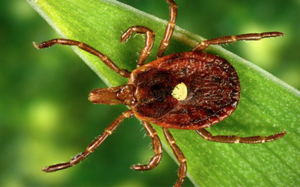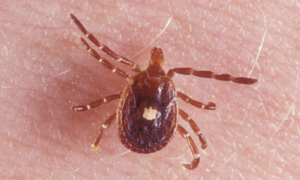After a few years of focusing heavily on the Deer Tick and Dog Tick, we find ourselves answering more and more questions about another tick: the Lone Star tick (Amblyomma americanum). This tick, named for the distinctive white spot on its back, has quite the reputation in the world of tick enthusiasts, biologists, and even medical professionals. It’s making news because it suddenly seems to be quickly expanding its range to the north and the west.
Lone Star Tick Range and Lifecycle
Historically, this resilient tick has been primarily found in the southeastern United States. However, recent years have witnessed an expansion of its territory, as it has been making its presence known in states as far north as Maine and as far west as Texas. Climate change, changes in land use patterns, and an increase in host populations are all believed to contribute to its expanding domain. The Lone Star tick is an adaptable creature, capable of thriving in a variety of habitats, from dense forests to grassy fields.
As far as lifecycle, the Lone Star Tick behaves alot like Dogticks or Blacklegged Ticks. Similar to other tick species, this arthropod undergoes four distinct life stages: egg, larva, nymph, and adult. In terms of activity, the Lone Star tick follows a seasonal pattern. Larvae typically emerge in the late summer and early fall, while nymphs are most active in the spring and early summer. Adults, on the other hand, are most prevalent during the summer months. However, it’s crucial to note that these ticks can be encountered throughout the year, especially in regions with milder winters. Plus, they are glad to feed on humans at every stage of their life, not just when they are adults. So, regardless of the season, it’s wise to stay vigilant and protect oneself when venturing into tick-prone areas.
How exactly does the Lone Star Tick differ from the dog tick or deer tick? A big difference is in the disease risk, as the Lone Star tick has gained notoriety due to its association with a condition known as “alpha-gal syndrome.” When bitten by a Lone Star tick, some individuals develop an allergy to red meat, as the tick’s saliva contains a sugar molecule called alpha-gal, which triggers an immune response in certain people. It can be quiet serious, and I write about it more later on.
The dog tick, also known as the American dog tick (Dermacentor variabilis), is a carrier of pathogens that can cause Rocky Mountain spotted fever and tularemia. Meanwhile, the deer tick, often referred to as the black-legged tick (Ixodes scapularis), is infamous for transmitting Lyme disease, a debilitating illness affecting thousands of individuals each year. The Lone Star tick, while not completely innocent, hasn’t been implicated as a primary vector for Lyme disease transmission.
Generally speaking, the black-legged tick and Lone Star tick carry more serious chronic diseases. That is why we are so alarmed when we see their range expand.
Repelling the Lone Star Tick
Repelling the Lone Star Tick is a very similar game to repelling other types of ticks. There are a few things to think about when preparing to tread into a tick-likely area.
Clothing
When venturing into tick-prone areas, it’s essential to dress defensively. Opt for long-sleeved shirts, long pants, and closed-toe shoes. Tucking your pants into your socks might not win you any fashion awards, but it can serve as an effective barrier against tick entry. Light-colored clothing is also recommended, as it allows you to see ticks much more easily.
Repellents
Tick repellents are highly-recommended (in my family, they are required) when in a tick-prone area. A variety of commercial tick repellents are available, containing active ingredients such as DEET, picaridin, or permethrin. Studies have shown that these repellents can be highly effective in repelling ticks, including the Lone Star tick. Applying repellents containing these ingredients to exposed skin and clothing can significantly reduce the likelihood of tick bites.
active ingredients such as DEET, picaridin, or permethrin. Studies have shown that these repellents can be highly effective in repelling ticks, including the Lone Star tick. Applying repellents containing these ingredients to exposed skin and clothing can significantly reduce the likelihood of tick bites.
Use repellents as directed. Some work better on clothing, others on skin. Some require re-application often, while others last longer. Remember, prevention is a continuous effort.
Natural Methods and Essential Oils
Another interesting avenue of research revolves around the potential use of natural repellents. Some studies suggest that essential oils work on ticks, such as geranium oil, eucalyptus oil, lemon eucalyptus oil, and geraniol. While these natural alternatives may be less potent than their chemical counterparts, they can still provide some level of protection.
If it’s me, though, I’m going with the tried-and-true commercial products.
Lone Star Tick Control
As the Lone Star tick continues its expansion and encroaches upon our yards and outdoor spaces, it’s essential for us to take proactive steps in controlling their population. Curbing the tick population around our homes can help minimize encounters and reduce the risk of tick bites. There are a few things you can do to yard-proof against ticks.
The best method to control tick populations in our yards is by removing their habitat. Ticks thrive in moist, shaded areas, such as tall grass, shrubs, and leaf litter. Maintaining a well-groomed yard can make it less appealing for ticks to reside. Regularly mowing the lawn, trimming vegetation, and raking up leaves and debris (such as wood or brush piles) can create an environment less conducive to tick survival.
Maintaining a well-groomed yard can make it less appealing for ticks to reside. Regularly mowing the lawn, trimming vegetation, and raking up leaves and debris (such as wood or brush piles) can create an environment less conducive to tick survival.
Creating a buffer around your yard can serve as a deterrent for ticks. Ticks aren’t huge fans of rocks or gravel. It doesn’t give them the cover they want, so they avoid it. If you can, consider a few feet of pea gravel, sand, or gravel on the perimeter of your yard, especially if it is a transition area from a wooded or long grass area.
Another strategy that has shown promise in controlling tick populations is the use of acaricides, which are pesticides specifically designed to target ticks. Studies have demonstrated that treating yard areas with acaricides, such as permethrin-based products, can effectively reduce tick abundance. They may also hurt pollinators, so don’t overuse them and only use them when completely necessary.
Encouraging natural predators of ticks can also aid in controlling their populations. Animals like chickens, guinea fowl, and opossums are known to consume ticks as part of their diet. But then again, do you really want possums around? They are pretty repulsive too!
A community approach is key to successful tick control. If your neighbors love having long, native grass and brush in their yard, you likely will only be able to get so far on tick population reduction. A coordinated plan of attach will get you much further.
Pets and Lone Star Ticks
The first question we get from many people is “will this tick hurt my pet?”
The answer is Yes for the Lone Star Tick. When these ticks bite pets, they can transmit various diseases, including ehrlichiosis, anaplasmosis, and Rocky Mountain spotted fever. These diseases can lead to symptoms such as fever, lameness, lethargy, loss of appetite, and even organ damage. Additionally, pets can also develop an allergic reaction to the saliva of Lone Star ticks, leading to itching, rashes, and discomfort. It is important to protect our pets.
To safeguard our pets from the harmful effects of Lone Star ticks, several preventive measures can be taken. Regularly checking pets for ticks, especially after spending time outdoors, is essential. Using tick preventive pet products such as spot-on treatments, oral medications, or tick collars, can effectively repel and kill ticks.
Alpha Gal
You can’t talk about Lone Star Ticks without talking about Alpha Gal Syndrome.
This peculiar condition, associated with the bite of a certain tick, has left meat lovers scratching their heads – and their bodies. Today, let’s delve into the world of alpha-gal syndrome, understand its dangers, and explore how it spreads, all while avoiding the complicated jargon that often accompanies scientific discussions.
At its core, Alpha Gal Syndrome is an allergy to red meat. Yes, you read that right: an allergy to juicy burgers, succulent steaks, and sizzling bacon. But what’s causing this strange reaction? It’s the saliva of a tiny arachnid known as the Lone Star tick.
When a Lone Star tick bites someone who eventually develops alpha-gal syndrome, it injects a sugar molecule called alpha-gal into the person’s bloodstream. For most of us, this molecule doesn’t cause any problems. But for those unlucky few, their immune systems go haywire and produce antibodies against alpha-gal.
When someone with Alpha Gal eats red meat, the antibodies in their system recognize the alpha-gal molecules present in the meat as a threat. This triggers an immune response, resulting in a range of symptoms that can include hives, itching, gastrointestinal distress, and in severe cases, even life-threatening anaphylaxis.
The tricky part about alpha-gal syndrome is that the symptoms don’t appear immediately after eating meat. It can take several hours for the allergic reaction to kick in, making it challenging to identify the exact cause of the symptoms. Imagine enjoying a delicious steak dinner, only to experience an allergic reaction hours later—it’s a perplexing and frustrating scenario for those affected.
Just like with Lyme disease, not everyone who gets bitten by a Lone Star tick will develop alpha-gal syndrome. It seems that some individuals are more susceptible to the tick’s alpha-gal payload, while others remain unaffected. Researchers are still working to unravel the exact reasons behind this variation in response.
Why is the Lone Star Tick’s Range Expanding?
It is not secret that the Lone Star Tick is typically thought of as a “Southeast” tick. Right now, though, it is making a hard push into Northeast and Midwest.
Climate change, habitat modification, and the movement of host animals are all suspected to be driving forces behind the Lone Star tick’s expansion. With rising temperatures and changing environmental conditions, areas that were once considered less favorable for these ticks are now becoming suitable habitats. Urbanization and deforestation also contribute to the transformation of landscapes, offering new opportunities for Lone Star ticks to thrive.






